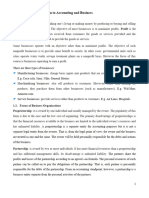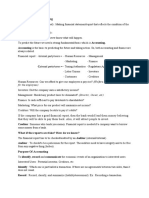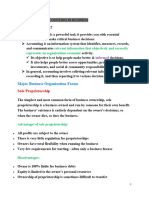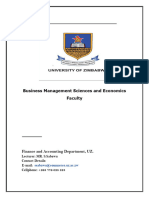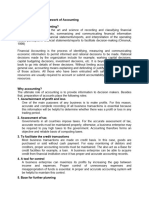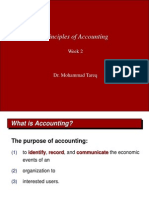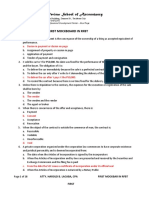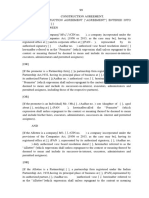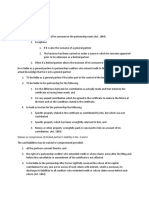Lecture 2 Accounts
Lecture 2 Accounts
Uploaded by
Amila HarshaniCopyright:
Available Formats
Lecture 2 Accounts
Lecture 2 Accounts
Uploaded by
Amila HarshaniCopyright
Available Formats
Share this document
Did you find this document useful?
Is this content inappropriate?
Copyright:
Available Formats
Lecture 2 Accounts
Lecture 2 Accounts
Uploaded by
Amila HarshaniCopyright:
Available Formats
Accounting a process of identifying, recording, summarizing, and reporting economic information to decision makers in the form of financial statements
Financial accounting focuses on the specific needs of decision makers external to the organization, such as stockholders, suppliers, banks, and government agencies The accounting system is a series of steps performed to analyze, record, quantify, accumulate, summarize, classify, report, and interpret economic events and their effects on an organization and to prepare the financial statements.
The Purpose of Accounting Provide information for stakeholders customers, shareholders, suppliers, etc. Provides the opportunity for the business to monitor its own activities Provides transparency to enable the firm to attract investment Reduces the chance for fraud not 100% successful!!
Financial and Management Accounting The major distinction between financial and management accounting is the users of the information. Financial accounting serves external users, such as investors, creditors, and suppliers. Management accounting serves internal users, such as top executives, management, and administrators within organizations.
Objectives of Financial Reporting
Provide information useful to economic decision makers
Allow decision makers to predict businesses future cash flows (and cash flows they will receive from these businesses) Provide information concerning businesses assets and liabilities and related transactions and events
The primary questions about an organization s success that decision makers want to know are: day? How well did the organization do during a given period? Financial and Management Accounting Accountants answer these primary questions with three major financial statements. Balance sheet A financial snapshot of a company at one point in time Income statement shows performance over a given period Statement of cash flows shows performance over a given period What is the financial picture of the organization on a given
Users of Accounting Information
Business Managers
Employees and Unions Investors and Creditors Tax Authorities Government Regulatory Agencies
Forms of Business Organizations
Types of Ownership Three basic forms of ownership: 1. Sole proprietorships 2. Partnerships 3. Company 1. Sole Proprietorship A separate organization with a single owner Tend to be small retail establishments and individual professional or service business The sole proprietorship is an individual entity that is separate and distinct from the personal activities of the owner. 2. Partnership An organization that joins two or more individuals who act as co-owners Dentists, doctors, attorneys, and accountants tend to conduct their activities as partnerships. The partnership is an individual entity that is separate and distinct from the personal activities of each of the partners.
3. Company An artificial entity created under state laws Company have limited liability company creditors have claims against company assets only. Individual investors are at risk only up to the amount they have invested in the company. Creditors cannot hold investors liable for the company s debts. Owners are called shareholders or stockholders.
Publicly owned vs. privately owned corporations
Public - Shares in the ownership are sold to the public on a stock exchange; the company can have many thousands of shareholders. Private - Shares in the ownership are owned by families, small groups of shareholders, or a single shareholder and are not sold to the public.
Stockholders and the Board of Directors
The board has the responsibility to ensure that management acts in the interests of the stockholders.
Primary Objective of a Business
Primary Objective of a Business The management of every business have two primary objectives: Earn a profit The difference from revenue and expenses Stay solvent having sufficient funds to pay debts as they fall due. Other Objective of a Business Providing jobs Protecting the environment Creating new and improved product Providing quality goods and services for less cost
Basic Principles of Accounting
The Accounting Entity Principle distinguishes each organizations from its owners and considering as individual business entity. The Historical Cost Principle assets (resources) recorded at their actual costs or the price paid to purchase them. The Going Concern Principle d assumed that the business entity will continue to operate I n the near future The Accounting Period Principle indefinite life can be assumed for most accounting entities, but the year has been adopted as the primary reporting period. The Matching Principle requires the matching against revenues of all the expenses incurred in earning the revenues during a specific time.
You might also like
- Csec Poa Handout 1Document28 pagesCsec Poa Handout 1Taariq Abdul-Majeed100% (3)
- Introduction To Financial AccountingDocument14 pagesIntroduction To Financial AccountingMohd Azhari Hani SurayaNo ratings yet
- Partnership LiquidationDocument17 pagesPartnership LiquidationIvo N50% (2)
- Accounting: The Language of BusinessDocument30 pagesAccounting: The Language of BusinessMuhammad AzamNo ratings yet
- Fabm MidtermDocument7 pagesFabm MidtermSamantha LiberatoNo ratings yet
- FOA I HandoutDocument88 pagesFOA I HandoutIbsa MohammedNo ratings yet
- Fundamental Part 1 Chapter 1Document5 pagesFundamental Part 1 Chapter 1kidusNo ratings yet
- Ffa AcowtancyDocument110 pagesFfa AcowtancyHasniza HashimNo ratings yet
- Discuss The Users of Financial Information Internal UsersDocument6 pagesDiscuss The Users of Financial Information Internal UsersStephen Pilar PortilloNo ratings yet
- Financial AccountingDocument3 pagesFinancial AccountingValentina HidayatNo ratings yet
- Principles of Accounting SummaryDocument9 pagesPrinciples of Accounting SummaryMichael BrandonNo ratings yet
- 1 Introduction Financial Accounting 1 (Cuacm105)Document17 pages1 Introduction Financial Accounting 1 (Cuacm105)priviledgeshambare2004No ratings yet
- Chapter 1Document15 pagesChapter 1bavanthinilNo ratings yet
- HandoutDocument4 pagesHandoutmishamomanedoNo ratings yet
- Chapter One IfrsDocument21 pagesChapter One Ifrsgebrezgi93821No ratings yet
- Chapter One FundamentalDocument18 pagesChapter One Fundamentalsamita2721No ratings yet
- Fundamental One Module EdittedDocument91 pagesFundamental One Module Edittedtt7117915No ratings yet
- Chapter OneDocument20 pagesChapter OneashenafiNo ratings yet
- Curs I - Business EnvironmentDocument8 pagesCurs I - Business EnvironmentSTANCIU DIANA-MIHAELANo ratings yet
- An Overview of Business Finance-1Document24 pagesAn Overview of Business Finance-1HamzaNo ratings yet
- Fiancial ReportDocument31 pagesFiancial ReportBloom MafiyaNo ratings yet
- Lecture 1Document31 pagesLecture 1api-275959008No ratings yet
- Accountig Chapter 1Document8 pagesAccountig Chapter 1Berhan TadesseNo ratings yet
- Financial Accounting SummaryDocument25 pagesFinancial Accounting SummarySofia EizingaNo ratings yet
- Introdution To AccountingDocument56 pagesIntrodution To Accountingrezel joyce catloanNo ratings yet
- CH 1 FAcc I @2013-1Document14 pagesCH 1 FAcc I @2013-1tamebirhanu696No ratings yet
- ACCN 101-Study ModuleDocument116 pagesACCN 101-Study ModuleblessedmabvunureNo ratings yet
- Brave Brands AccountingDocument6 pagesBrave Brands AccountingNgoni MukukuNo ratings yet
- 1-Introduction To AccountingDocument28 pages1-Introduction To AccountingKei TamundongNo ratings yet
- FoA I Chapter OneDocument11 pagesFoA I Chapter OneyeshiwasdagnewNo ratings yet
- CH 1 FAcc I @2015Document21 pagesCH 1 FAcc I @2015Gedion FeredeNo ratings yet
- Accounting For Non-Financial People-Part 1Document75 pagesAccounting For Non-Financial People-Part 1ferroalNo ratings yet
- Module For AccountingDocument46 pagesModule For AccountingJhefz KhurtzNo ratings yet
- IntroductionDocument53 pagesIntroductionhippop kNo ratings yet
- Principles of Accounting I ModuleDocument107 pagesPrinciples of Accounting I ModuleGirum zewde AsfawNo ratings yet
- Chapter 1: Session 1 Introduction To Financial AccountingDocument161 pagesChapter 1: Session 1 Introduction To Financial AccountingHarshini Akilandan100% (1)
- 1 Introduction To FinanceDocument23 pages1 Introduction To FinanceIsabel EscobarNo ratings yet
- Chapter One NewDocument11 pagesChapter One Newneway gobachewNo ratings yet
- Workbook AccountsDocument38 pagesWorkbook AccountsSummyyaNo ratings yet
- Introduction To Financial Accounting LECTURE ONEDocument30 pagesIntroduction To Financial Accounting LECTURE ONEziajehanNo ratings yet
- CB Chap 1Document10 pagesCB Chap 1Christianne Joyse MerreraNo ratings yet
- Financial Accounting (F3/FFA) : July 2012 SessionDocument148 pagesFinancial Accounting (F3/FFA) : July 2012 SessionxxxtrememohsinNo ratings yet
- Financial Accounting and Reporting Basic Business Week 1 5 1Document16 pagesFinancial Accounting and Reporting Basic Business Week 1 5 1criseranista6No ratings yet
- General AccountingDocument70 pagesGeneral AccountingPenn CollinsNo ratings yet
- Financial Accounting (F3/FFA) : July 2012 SessionDocument148 pagesFinancial Accounting (F3/FFA) : July 2012 SessionAung Zaw HtweNo ratings yet
- Advanced Accounting Volume 2 1Document4 pagesAdvanced Accounting Volume 2 1Angelica Jenzel Masaga NamNo ratings yet
- Discussion QuestionsDocument4 pagesDiscussion QuestionsPatrick John RifilNo ratings yet
- Intoduction To AccountingDocument19 pagesIntoduction To AccountingRachel Ann CapanzanaNo ratings yet
- Theoretical Framework of AccountingDocument13 pagesTheoretical Framework of Accountingmarksuudi2000No ratings yet
- Personal Notes For Unit 1Document3 pagesPersonal Notes For Unit 1owenl740No ratings yet
- Accounting Is An Information System That IdentifiesDocument5 pagesAccounting Is An Information System That Identifiesniser88No ratings yet
- Accountancy Chapter 1Document9 pagesAccountancy Chapter 1Yhale DomiguezNo ratings yet
- What Is An Entrepreneur?Document4 pagesWhat Is An Entrepreneur?Maria Fe IgnacioNo ratings yet
- Scope of Financial Accounting_240726_084855 (1)Document4 pagesScope of Financial Accounting_240726_084855 (1)sahotaharpreetkaur090No ratings yet
- Financial Statement AnalysisDocument5 pagesFinancial Statement Analysisyashvardan shahNo ratings yet
- Finance of Computer Before MidDocument9 pagesFinance of Computer Before Midsamisultan6789012No ratings yet
- All NotebookDocument88 pagesAll NotebookmsjoyevangelistaNo ratings yet
- Module 1Document8 pagesModule 1Carol VillamorNo ratings yet
- DK Essential Managers: Understanding AccountsFrom EverandDK Essential Managers: Understanding AccountsRating: 4 out of 5 stars4/5 (2)
- "The Language of Business: How Accounting Tells Your Story" "A Comprehensive Guide to Understanding, Interpreting, and Leveraging Financial Statements for Personal and Professional Success"From Everand"The Language of Business: How Accounting Tells Your Story" "A Comprehensive Guide to Understanding, Interpreting, and Leveraging Financial Statements for Personal and Professional Success"No ratings yet
- Doing Business in Tanzania, Questions and AnswersDocument26 pagesDoing Business in Tanzania, Questions and Answersimran hameerNo ratings yet
- Partnership Agreement: 1 Definitions and InterpretationsDocument18 pagesPartnership Agreement: 1 Definitions and Interpretationsfrans NgobeniNo ratings yet
- FAR 2 Q2 - Sample Problems With Solutions - FOR EMAILDocument11 pagesFAR 2 Q2 - Sample Problems With Solutions - FOR EMAILJoyce Anne GarduqueNo ratings yet
- Grad Hack 5 Steps To KPMGDocument9 pagesGrad Hack 5 Steps To KPMGJoseph Heyington100% (2)
- JS Hospitality Services Private LTD - Drafted by SupantaDocument37 pagesJS Hospitality Services Private LTD - Drafted by SupantaPavlov Kumar HandiqueNo ratings yet
- 11 Business Studies SP 1Document7 pages11 Business Studies SP 1Thakur GamingNo ratings yet
- Summative Test No. 1Document6 pagesSummative Test No. 1Shema Sheravie Ivory QuebecNo ratings yet
- Lec1 - Introduction To AccountingDocument55 pagesLec1 - Introduction To AccountingChoo Yie100% (1)
- Partnership Development MOUDocument2 pagesPartnership Development MOUMeshach Jedidiah MeshachNo ratings yet
- Anizational Form and Alternative MotivDocument20 pagesAnizational Form and Alternative Motiv12345harsha123456789No ratings yet
- Bank Bargains and Entangled PolEconDocument31 pagesBank Bargains and Entangled PolEconPrieto PabloNo ratings yet
- Sample Paper 2013 Class XII Subject Accountancy: Time: 3hours Maximum Marks: 80 General InstructionsDocument8 pagesSample Paper 2013 Class XII Subject Accountancy: Time: 3hours Maximum Marks: 80 General Instructions9chand3No ratings yet
- Instructions For Form W-8BEN: (Rev. October 2021)Document9 pagesInstructions For Form W-8BEN: (Rev. October 2021)Mario SierraNo ratings yet
- Principles of Accounting: Week 2Document56 pagesPrinciples of Accounting: Week 2pinkyNo ratings yet
- Unit 3. Creating An Enterprises: Desired Learning OutcomesDocument25 pagesUnit 3. Creating An Enterprises: Desired Learning OutcomesJane Barcelona EvangelistaNo ratings yet
- Entrepreneurship Examination 2Document5 pagesEntrepreneurship Examination 2tofik2No ratings yet
- First Mockbar in RFBT With AnswersDocument18 pagesFirst Mockbar in RFBT With AnswersMichaelJayCuturaMatolNo ratings yet
- Finance Compendium PartII DMS IIT DelhiDocument55 pagesFinance Compendium PartII DMS IIT DelhiKhyati ChauhanNo ratings yet
- Multiple Choice QuestionsDocument4 pagesMultiple Choice QuestionsIrish SantiagoNo ratings yet
- Collaborative RelationshipsDocument1 pageCollaborative Relationshipsnehachopra1990No ratings yet
- Construction Agreement TNRERADocument16 pagesConstruction Agreement TNRERAgeniusganyNo ratings yet
- PARTNERSHIP Bar Q&AsDocument2 pagesPARTNERSHIP Bar Q&Asaldenamell100% (1)
- The Impact of Taxpayer EducationDocument112 pagesThe Impact of Taxpayer EducationyukeNo ratings yet
- GST at 6 - All Key Observations by SC and HC - 5 June 2023 - CA Pritam Mahure and Asso.Document346 pagesGST at 6 - All Key Observations by SC and HC - 5 June 2023 - CA Pritam Mahure and Asso.Nitesh GargNo ratings yet
- Placer County Fictitious Business NameDocument2 pagesPlacer County Fictitious Business NameSierra Nevada Media Group100% (1)
- Waiver or Compromise of Limited Partner's Liability in No. 3 and 4Document2 pagesWaiver or Compromise of Limited Partner's Liability in No. 3 and 4Gray JavierNo ratings yet
- Business Law Course Guide (BMG542)Document23 pagesBusiness Law Course Guide (BMG542)Chachamaru RinNo ratings yet
- 5 MVAr CAP BANKDocument64 pages5 MVAr CAP BANKM DuraiNo ratings yet
- Presentation On GCC For Works ServicesDocument42 pagesPresentation On GCC For Works ServicesSaptarshi PalNo ratings yet





